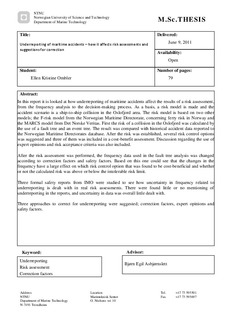Underreporting of maritime accidents – how it affects risk assessments and suggestions for correction
Master thesis

View/
Date
2011Metadata
Show full item recordCollections
- Institutt for marin teknikk [3397]
Abstract
In this report it is looked at how underreporting of maritime accidents affects the results of a risk assessment, from the frequency analysis to the decision-making process. As a basis, a risk model is made and the accident scenario is a ship-to-ship collision in the Oslofjord area. The risk model is based on two other models; the F-risk model from the Norwegian Maritime Directorate, concerning ferry risk in Norway and the MARCS model from Det Norske Veritas.
First the risk of a collision in the Oslofjord was calculated by the use of a fault tree and an event tree. The result was compared with historical accident data reported to the Norwegian Maritime Directorates database. After the risk was established, several risk control options was suggested and three of them was included in a cost-benefit assessment. Discussion regarding the use of expert opinions and risk acceptance criteria was also included.
After the risk assessment was performed, the frequency data used in the fault tree analysis was changed according to correction factors and safety factors. The correction factors were in accordance with a degree of underreporting of 30 and 40 %.
Based on this one could see that the changes in the frequency have a large effect on which risk control option that was found to be cost-beneficial and whether or not the calculated risk was above or below the intolerable risk limit.
Three formal safety reports from IMO were studied to see how uncertainty in frequency related to underreporting is dealt with in real risk assessments. There were found little or no mentioning of underreporting in the reports, and uncertainty in data was overall little dealt with.
Three approaches to correct for underreporting were suggested; correction factors, expert opinions and safety factors. None of the approaches was found to be a perfect solution. A combination of a conservative approach and some use of expert opinions where this is needed were found to be the best solution. Correction factors for underreporting cannot be established before the degree of underreporting is known. Therefore it should be focused on how to find the degree of underreporting related to maritime accidents. The road transport sector has come up with suggestions for correction factors related to unreported accident and collaboration between the different transport sectors could be beneficial.
It is also mentioned that uncertainty related to underreporting is only one of many uncertainties when looking at a risk assessment. Uncertainty in general is an important aspect and should be dealt with. Sensitivity analyses should be a part of risk assessment reports.